March 19, 2024
Block by block, an organization addresses the trauma underlying community needs
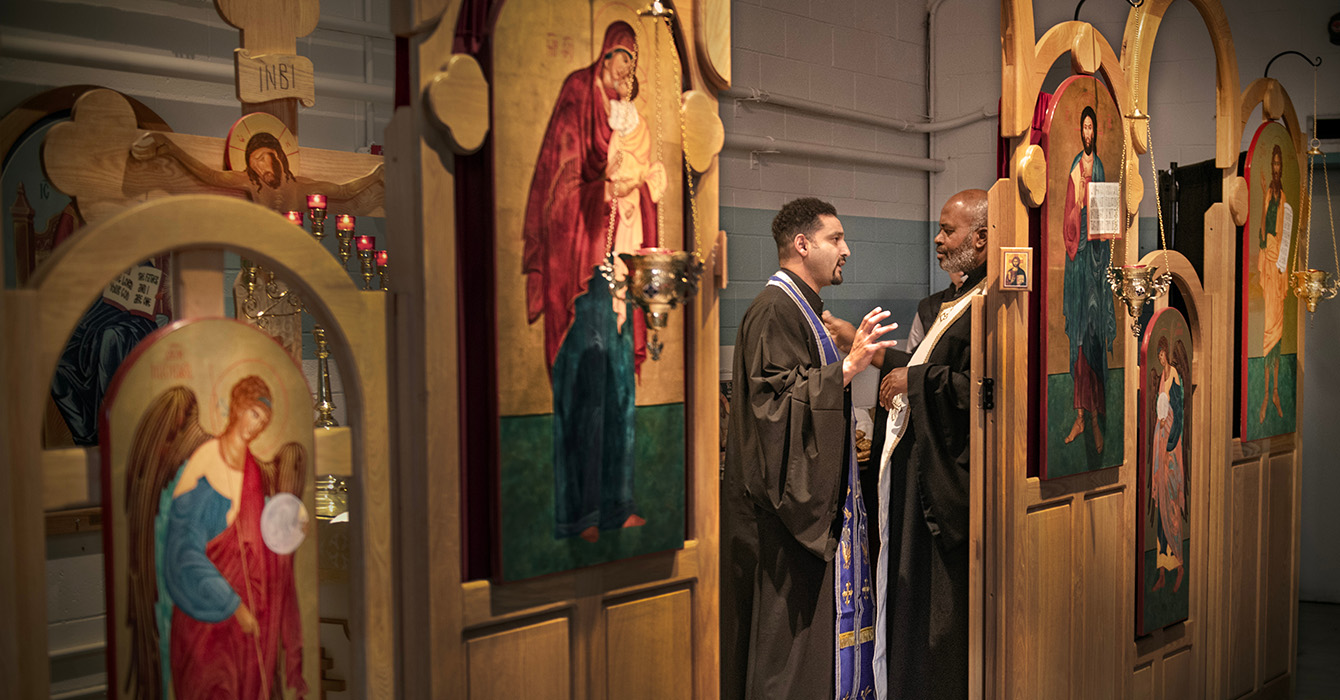
The Rev. Paul Abernathy and the Rev. Maximos Nnachette speak after a prayer service at the Neighborhood Resilience Project.
In Pittsburgh, a Black Orthodox priest heads the Neighborhood Resilience Project, an innovative, faith-based community development program.
In 2011, the Rev. Paul Abernathy, then an Orthodox priest fresh out of seminary, started a neighborhood ministry in the Hill District, a predominantly Black section of Pittsburgh that had long suffered from economic decline. He did what he could to make an impact: providing food and clothing, offering comfort or a prayer when someone was in distress. But he soon realized there were even deeper needs.
“What really struck me early on,” Abernathy said, “was the immense amount of suffering.”
A person would come in asking for help getting a doctor’s appointment or a bus pass and would end up talking about eviction, gun violence, systemic racism, unemployment, food insecurity, abuse, addiction or incarceration.
The serious experiences that came up all represented ongoing traumas. It reminded Abernathy of the post-traumatic stress he had been warned about when he was an Army staff sergeant in Iraq. Moreover, the traumas affected everyone in the neighborhood.
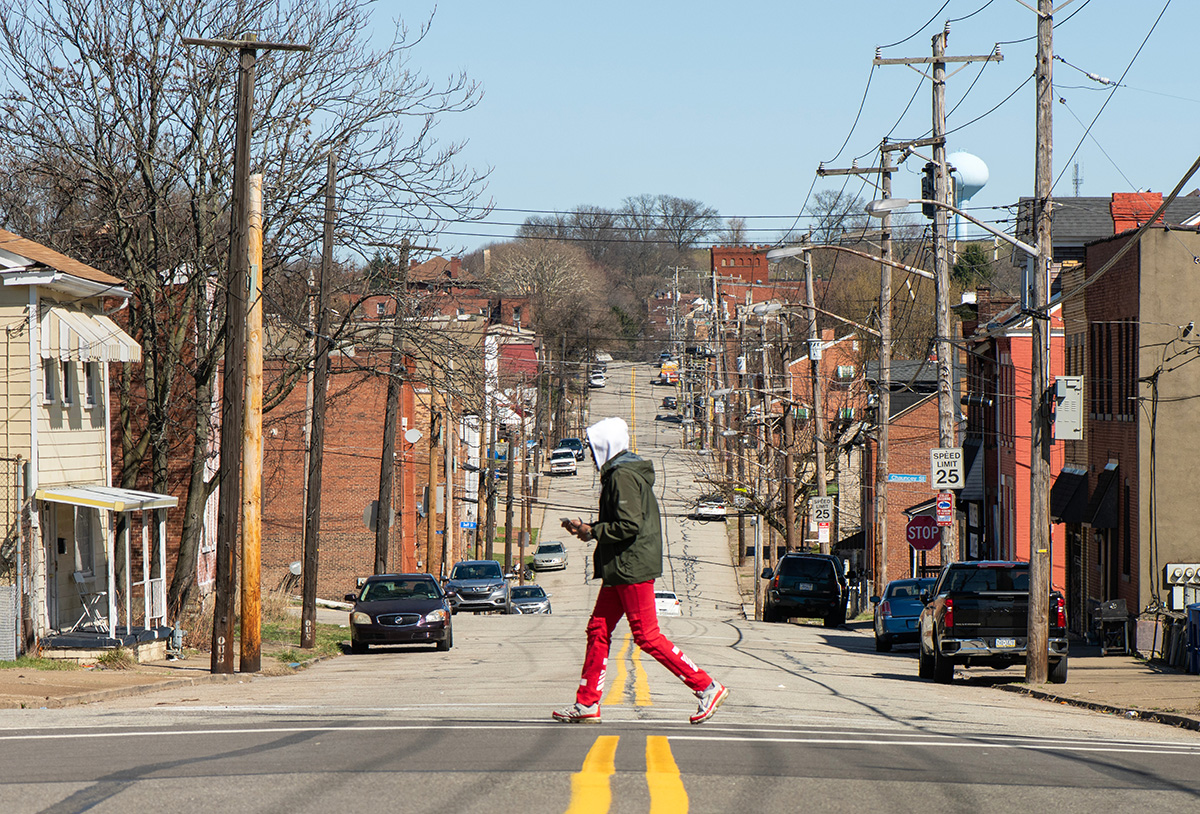
“Even if someone didn’t have a direct experience of trauma, that trauma was all around, all the time,” he said.
Abernathy, who is African American and was raised Catholic, attended a Black Baptist church in college before converting to Orthodoxy in 2002. He became convinced that unless that underlying suffering could be addressed, any efforts to help his constituents wouldn’t last.
“I’ve seen too many people get jobs and lose jobs,” he said in a 2016 TEDx talk. “I’ve seen too many people get into housing and lose housing. Why? Because they have been traumatized to the point that they are not healthy enough to sustain the opportunities that were placed at their feet.”
True community development, he came to believe, first required healing.

Abernathy found two researchers at nearby Duquesne University who were specialists in trauma counseling and community mental health and facilitated a series of discussions with them and community members.
He learned that 65% of African Americans have a lifetime exposure to trauma — long-term, repeated experiences that are stressful or frightening. He learned that trauma can be passed from generation to generation, with tangible effects on health. According to data from the National Center for Health Statistics, the average life expectancy in parts of the Hill District is nearly 20 years less than in the city’s wealthiest neighborhoods.
These discussions ultimately led to the creation of the Neighborhood Resilience Project, a multifaceted, faith-based community outreach program headquartered in the Hill District, with Abernathy as its CEO and his wife Kristina Abernathy as its chief development officer.
What are the underlying issues impacting your community?
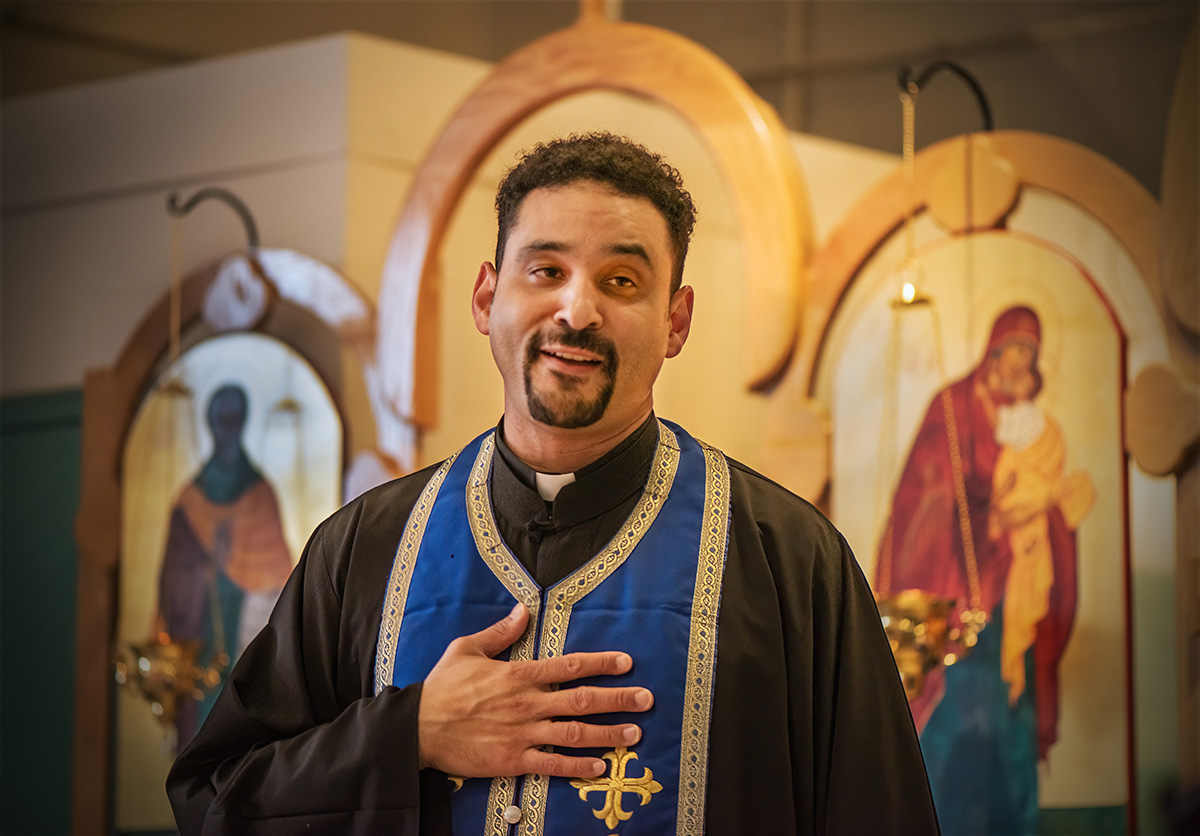
Now in its 12th year, the project offers wide-ranging services, from a food pantry, support groups and educational seminars to a trauma response team that’s dispatched after incidents of gun violence. The project serves people not just in the Hill District but throughout Pittsburgh and Allegheny County. It’s also attracted attention from a number of communities elsewhere, all seeking to learn from a model Abernathy calls trauma-informed community development.
Food, clothing and dental checkups
On a recent Wednesday morning at the Neighborhood Resilience Project’s headquarters, a three-story building on the northern edge of the Hill District, social worker Kathy Pehanich is meeting with a woman who recently lost her job and came in for help with paying her rent and utilities.
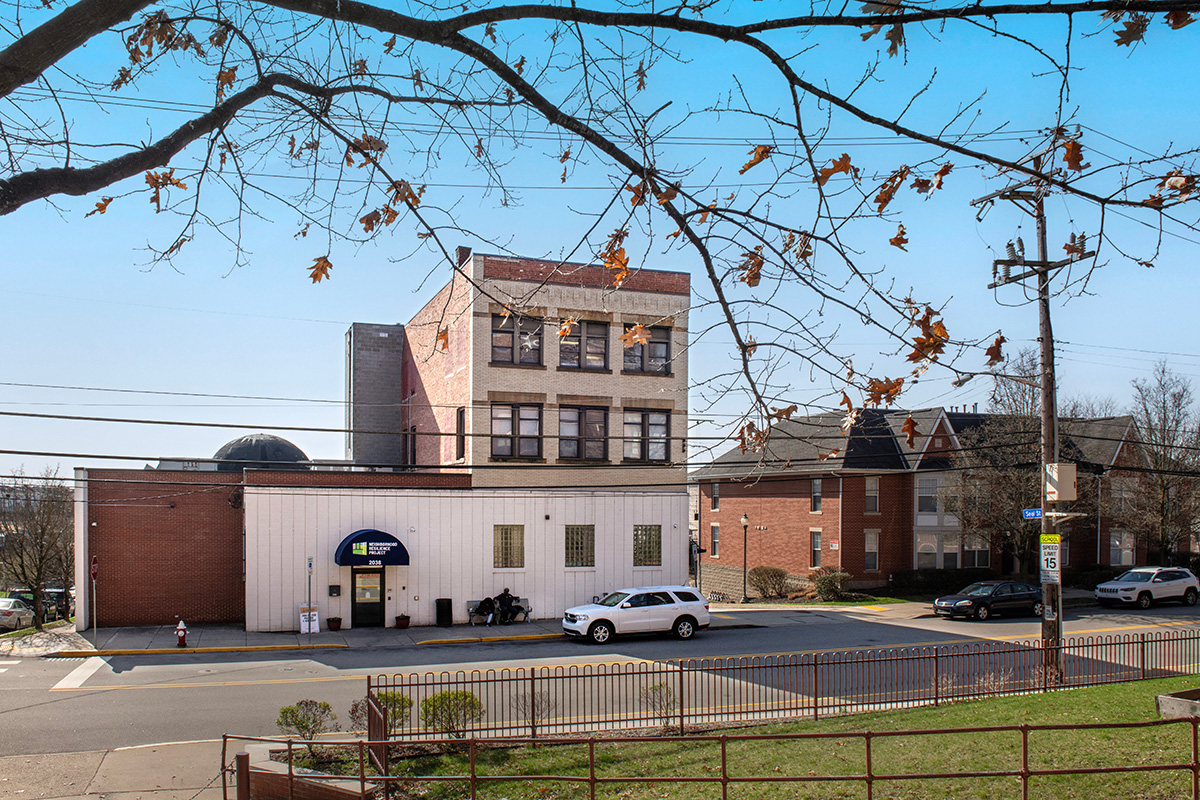
Pehanich’s office is cramped — not much bigger than a walk-in closet — with cinder block walls painted white and hung with prints of several Orthodox icons. (Orthodox iconography can be seen on walls throughout the site: St. Luke the Evangelist, St. Thais of Egypt, Christ Pantokrator, Holy Mother of God, St. Nicholas and others.) Pehanich was a drug and alcohol counselor earlier in her career; she began volunteering at the Neighborhood Resilience Project one day a week and now is part of the paid staff.
Much like an emergency room staffer, Pehanich never knows who might walk in next — perhaps a job seeker needing help getting a birth certificate, a tenant with a rent payment overdue, a woman fleeing domestic abuse. In the winter especially, Pehanich fields calls daily from people needing a place to sleep, and she works the phones in hopes of getting them beds at one of the city’s homeless shelters.
Some regulars show up a few times a week just to socialize, have a cup of coffee or attend the daily Orthodox service at noon. The steady flow of clientele creates a sense of community that Pehanich didn’t sense when she was a substance abuse counselor and saw each client once a week at most.
In the basement, volunteers and staff have formed an assembly line, stuffing food items into plastic bags for the Backpack Feeding Program. The Neighborhood Resilience Project delivers more than 1,200 bags each week to 25 area schools, rec centers and other sites, where they’re distributed to children who need them.
“For some kids, their only meal is what they get at school,” said Bisrat Tesfagiorgis, who oversees the effort. “Our program works to make sure that the children are fed over the weekend.”
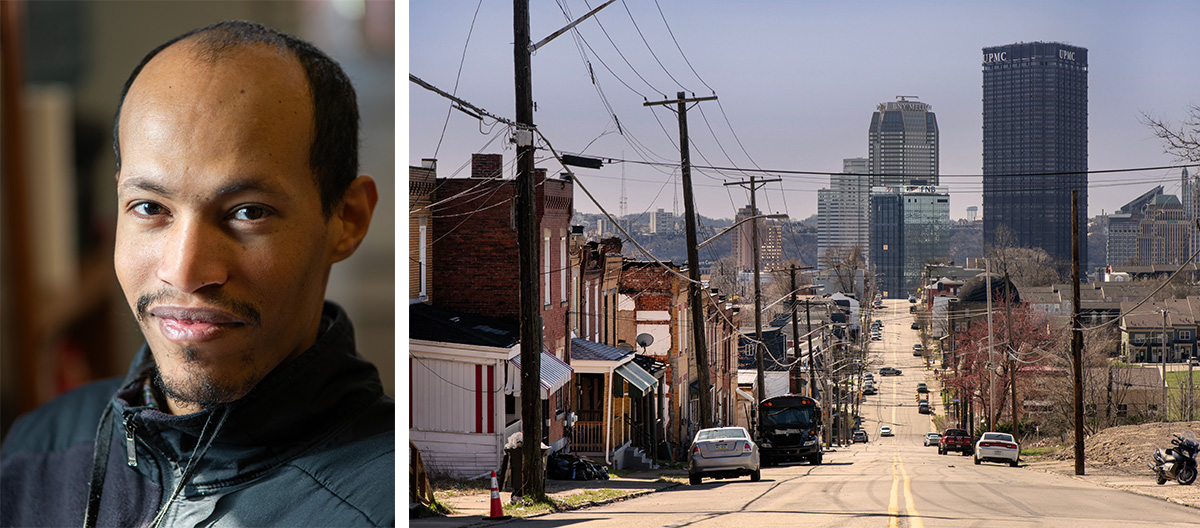
In the early years of the program, the food items (ramen noodles, macaroni and cheese, animal crackers, small boxes of cereal, boxed juice) were delivered in a backpack — hence the program’s name. But getting more than a thousand students to return the backpacks for reuse each week proved unrealistic, so now the food is packed into plastic grocery bags.
The building’s lower level also houses a food pantry and a clothing pantry (socks in particular are always in demand). Tesfagiorgis remembers a recent incident typical of the multiple ways the Neighborhood Resilience Project can help.
A man showed up one day, upset about the death of a close family member. “We were talking,” Tesfagiorgis said, “and I was just trying to pray, asking, ‘How can I be helpful?’ Then he said, ‘I wish I could go to the funeral, but I don’t have anything nice to wear.’ So I brought him down here,” she said, gesturing to the clothing pantry. The man quickly found a suit and a pair of shoes, and — at least for the moment — his mood noticeably brightened.
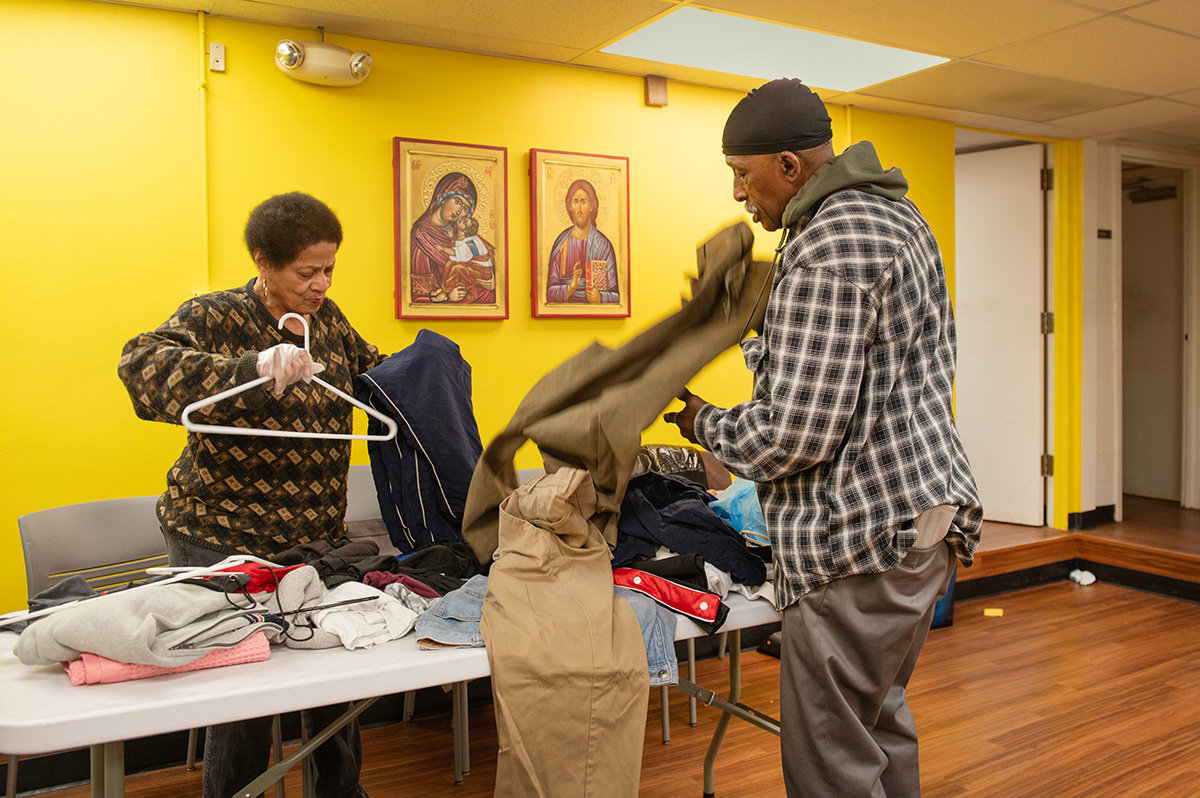
On the third floor, a health clinic staffed by volunteer physicians and dentists provides free care to a clientele that largely has no health insurance. With two exam rooms, two dental rooms and a medical lab, providers can offer a range of primary care services and make basic medications available at no cost.
For more advanced care, the Neighborhood Resilience Project can refer a patient to one of its partners — a local cardiologist who has agreed to see patients for free, for example, or another free clinic that happens to have a pulmonologist on staff. In addition, according to patient care specialist Paige Sarkaria, many area hospitals offer financial assistance.
“We can refer a patient to a hospital for, say, an imaging procedure, and then we help them apply for the hospital’s assistance program,” she said.
Like most of the services of the Neighborhood Resilience Project, the clinic has grown. In 2022, it recorded 244 patient visits; in 2023, that number jumped to 421.
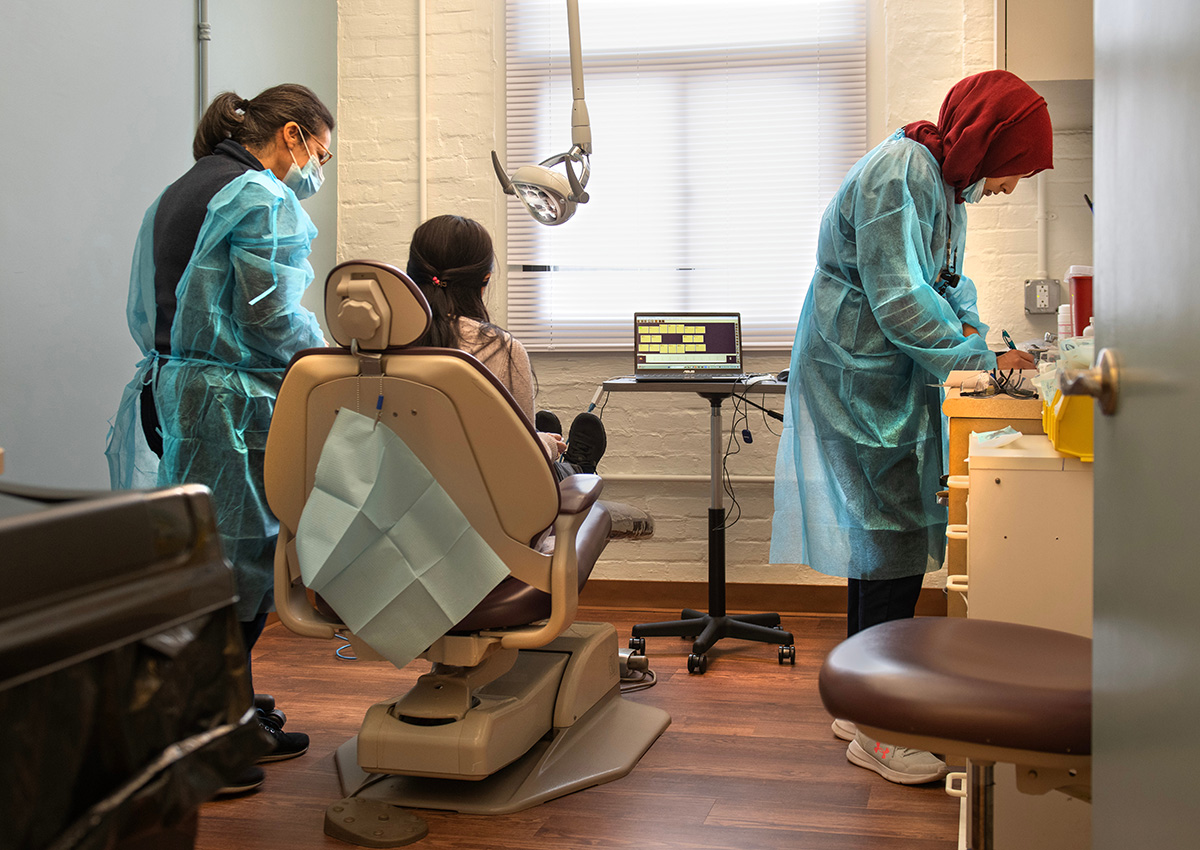
The health outreach isn’t confined to the Neighborhood Resilience Project building. A team of trained community health deputies spends time out on the streets, educating residents about health issues.
During the peak of the COVID pandemic, more than 100 deputies, often with Abernathy in the lead, went door to door to talk about how to stay safe from the virus — a special challenge in neighborhoods where multiple generations live together in crowded homes. They also recruited Black volunteers to take part in Moderna vaccine trials at the University of Pittsburgh, mindful that the pool of participants in such trials too often is predominantly white.
Psychological first aid
Perhaps the most innovative service that the Neighborhood Resilience Project provides, and the one that best exemplifies its trauma-centered approach, is the trauma response team. The team’s job is simple yet ambitious: to provide a healing presence — psychological first aid, they call it — at the scene of gun violence.
Each morning, four staff members gather in a room on the top floor of the Neighborhood Resilience Project building and begin to sift through the available information on any new homicides in the county.
The intel comes from social media, police reports, news stories online and tips from police or social workers. Ultimately, the staff may conclude that a deployment is needed, and the call goes out to a team of volunteers (who, like the staff, are trained in public safety, CPR, first aid and mental health first aid).
The staff and volunteers gather at the building, undergo a briefing on the details of the situation, pray together and then head out in one of two 31-foot RVs emblazoned with the Neighborhood Resilience Project logo.
How can your ministries embrace being trauma-informed?
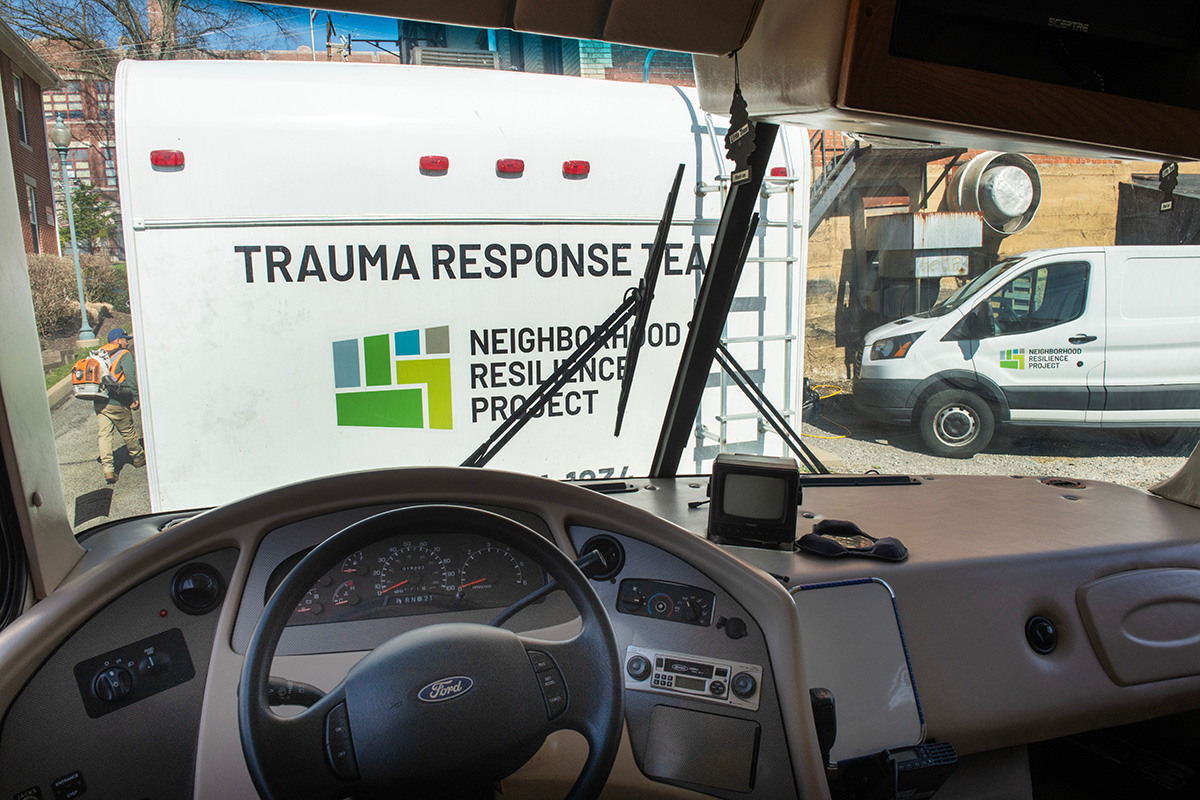
They park near the scene for several hours; some team members go out canvassing, introducing themselves to people they encounter, while others wait in the RV in case someone knocks on the door and says, “I need to talk.”
The RV has water bottles, food, a private room and stuffed animals (“trauma teddies”) for helping comfort children. The idea is to serve as a sympathetic ear to whoever needs it: a family member of the victim or perpetrator, a bystander — anyone who has been affected. Sometimes they help the person notify relatives. Sometimes they pray. Often they hand out a card with the Neighborhood Resilience Project phone number and a list of other available resources.
Andre Jacobs is program manager for the trauma response team. A native of Pittsburgh, he served three deployments with the Marines in Afghanistan and suffered afterward with PTSD. He credits his faith with helping him recover — “I had to have the courage to say, ‘I’m not OK, God,’” he said — and sees his work with the trauma response team as a way of giving back.
“I would just be foolish not to pass on the teachings and understandings that I now have,” Jacobs said. He also makes sure that the team isn’t known solely for its work at the scene of tragedies; they’ve also set up a hamburger grill on occasion at various neighborhood locations — “you know, just to put a few smiles on faces,” he said — and they conduct educational programs to help raise awareness of the trauma that often underlies violence.
A team approach to reducing violence
The Neighborhood Resilience Project is also taking the lead on a countywide project to reduce gun violence. Allegheny County sees more than 120 homicides per year on average, according to county data, and while Black men make up just 6% of the county population, they are the victims in 66% of the homicides. Gun violence tends to be geographically concentrated, according to Abernathy.
“There are 30,000 blocks in Allegheny County, and of those 30,000 blocks, gun violence happens in 0.3% of them. About 90 blocks.” Several of those hot spots are in the Hill District.
What challenges should be addressed in early collaborations?
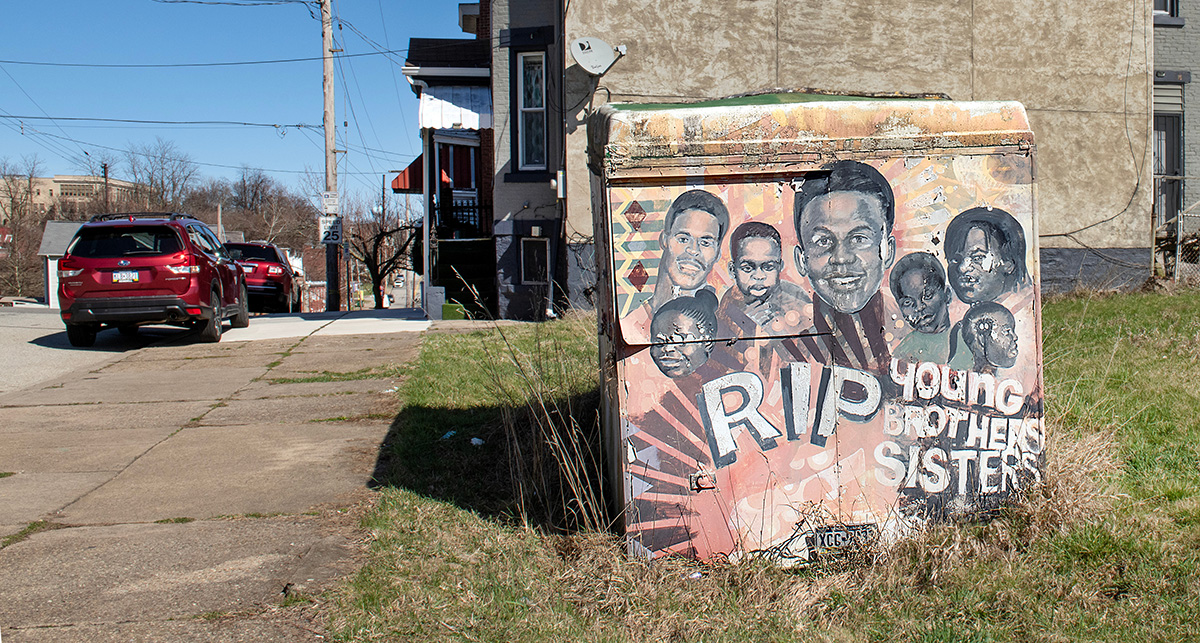
In early 2023, the county’s Department of Human Services pledged at least $50 million over five years toward its new Community Violence Reduction Initiative, with an emphasis on a public health approach — treating gun violence as a disease and addressing its underlying causes.
It’s in sync with the trauma-informed approach that Abernathy embraces, and in fact, the Neighborhood Resilience Project was chosen to be the countywide convener of the effort. The Neighborhood Resilience Project hosted the first summit on violence reduction last June, bringing together 200 partners from organizations throughout the county.
“We talked about what collaboration looks like,” said Quinten Boose, the director of violence reduction at the Neighborhood Resilience Project. “We talked about the hot spots, the data, the generational traumas, the root causes — how are we as a county going to address that.”
Boose is a former Pittsburgh city police officer with experience as a special victims unit detective and crisis negotiator; in 2023, he finished a master of public policy and management degree at the University of Pittsburgh. His job in the countywide project is to corral hundreds of partners from dozens of community and government organizations to work together.
It’s early in the process, but Boose is especially intrigued by an approach called the Omaha 360 model, which heavily emphasizes the collaboration of multiple stakeholders. A primary component of the model is weekly meetings involving law enforcement and residents, to reduce the disconnect between police and community members. Omaha 360 led to a 74% decrease in gun violence over a 10-year period in Omaha and has since been used as a model by other cities.
How do you foster a culture of continuous learning in your collaborations?
Meanwhile, the Neighborhood Resilience Project overall is proving to be a model for other communities throughout the country. In addition to his TEDx talk, Abernathy has given numerous media interviews, convened two trauma-informed community development institutes, and hosted officials from such locations as Richmond, Virginia; Indianapolis, Indiana; Sarasota, Florida; and the Wind River Indian Reservation in Wyoming.
Some have replicated the Neighborhood Resilience Project in their communities or begun a variant of it. They are exploring ways that they, too, can adopt the Neighborhood Resilience Project’s goal: to heal neighborhoods, one block at a time.
Questions to consider
- What are the underlying issues impacting your community?
- How can your ministries embrace being trauma-informed?
- What challenges should be addressed in early collaborations?
- How do you foster a culture of continuous learning in your collaborations?
